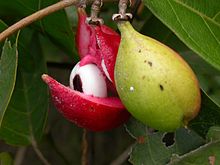Paullinia pinnata
| Paullinia pinnata | ||||||||||||
|---|---|---|---|---|---|---|---|---|---|---|---|---|

Paullinia pinnata , inflorescence |
||||||||||||
| Systematics | ||||||||||||
|
||||||||||||
| Scientific name | ||||||||||||
| Paullinia pinnata | ||||||||||||
| L. |
Paullinia pinnata (Spanish bejuco de costilla ) is a species of plant that belongs to the soap tree family (Sapindaceae). It has an African- Neotropical distribution.
The uses range from arrow poison and poison for fishing to applications in homeopathy . In addition, the white aril should be edible.
description
Vegetative characteristics
Paullinia pinnata grows as a shrubby climbing plant and reaches heights of 2.5 to 8 m, and up to 15 m should occasionally be reached. The stem axis is dark brown, sharply ribbed and can reach a diameter of up to 3.8 cm at the base.
The leaves are unpaired with five partial leaves, 15 to 25 (rarely only 5) cm long and 8 to 20 cm wide. The petiole is up to 10 cm long, like the rhachis , it is winged with a 0.5 to 1.3 cm wide wing. The partial leaves are sessile or stand on short stalks, they are egg-shaped, elliptical or rhombic in shape. The upper leaf has a length of 7 to 15 cm and a width of 3.5 to 8 cm, the side leaves are only 3.5 to 10 cm long and 1.7 to 5 cm wide. They are tapered, pointed or blunted towards the front and heart-shaped, wedge-shaped or narrowed at the base. The margins are almost entire or serrated towards the tip, jagged or slightly lobed. The leaves are almost leathery, shiny and hairless, only on the underside there is a slight hairiness along the leaf veins, which is tufted in the branches. The side veins are very pronounced.
Inflorescences and flowers
The inflorescence standing in the axils of the upper leaves is a thyrsus . It is 5 to 10 cm long, with the inflorescence stem about one to three times as long as the flower-bearing part. A couple of tightly screwed tendrils are formed at the tip of the inflorescence. The inflorescences are only occasionally sessile. The inflorescence axis is hairy brownish, the flower stalks are 0 to 3 mm long. The flowers are five to nine (rarely only three or four) in zymotic groups, the terminal flower is usually purely female, while the rest are purely male. The flowers are yellowish, cream-colored or white, 5 to 6 mm long and fragrant. The sepals are egg-shaped and irregularly shaped. The outer ones have a length of 1.5 mm while the inner ones become 4 mm long. They are finely haired on the outside. The tongue-shaped petals are white, almost the same shape and about 5 mm long. The scales which make up 3/4 of the petals are irregularly combed, ciliate and have a yellowish tip. The flower base is on one side of the androgynophore , it is ciliate and consists mainly of two large and two smaller, ear-shaped glands. Five long and three short stamens and eight staminodes are formed, the anthers of the stamens are white. The ovary is hairy, the pen divided into three.
Fruits and seeds
The fruit is green at first, but later turns red or pinkish red. It is inverted ovoid to elongated inverted ovoid. It becomes 2.4 to 3.6 cm long and 1.1 to 1.4 cm wide. The tip is rounded or notched, the base is spiky and strongly tapered. The fruit is three-furrowed, initially finely hairy, but later balding and finely notched and cracking open. The seeds are black, elongated-elliptical, 1 to 1.1 cm long and 7 to 8 mm wide, the aril is white.
Chromosome number
The number of chromosomes is 2n = 24.
Occurrence
This species occurs in tropical Africa , on Madagascar , as well as in subtropical America at altitudes between 0 and 1600 m. It grows in evergreen and mixed forests.
use
The stem axes are used to make ropes, walking sticks and in basket making (e.g. as fish traps). The plant was also used as a poison for fish and arrows. The white aril is said to be edible.
literature
- Davies and B. Verdcourt: Flora of Tropical East Africa , Volume 61, 1998. Online at Aluka. (engl.)
- AW Exell: Flora Zambesiaca , Volume 2, Part 2, 1966. Page 494.
Individual evidence
- ↑ Paullinia pinnata at Tropicos.org. In: IPCN Chromosome Reports . Missouri Botanical Garden, St. Louis
